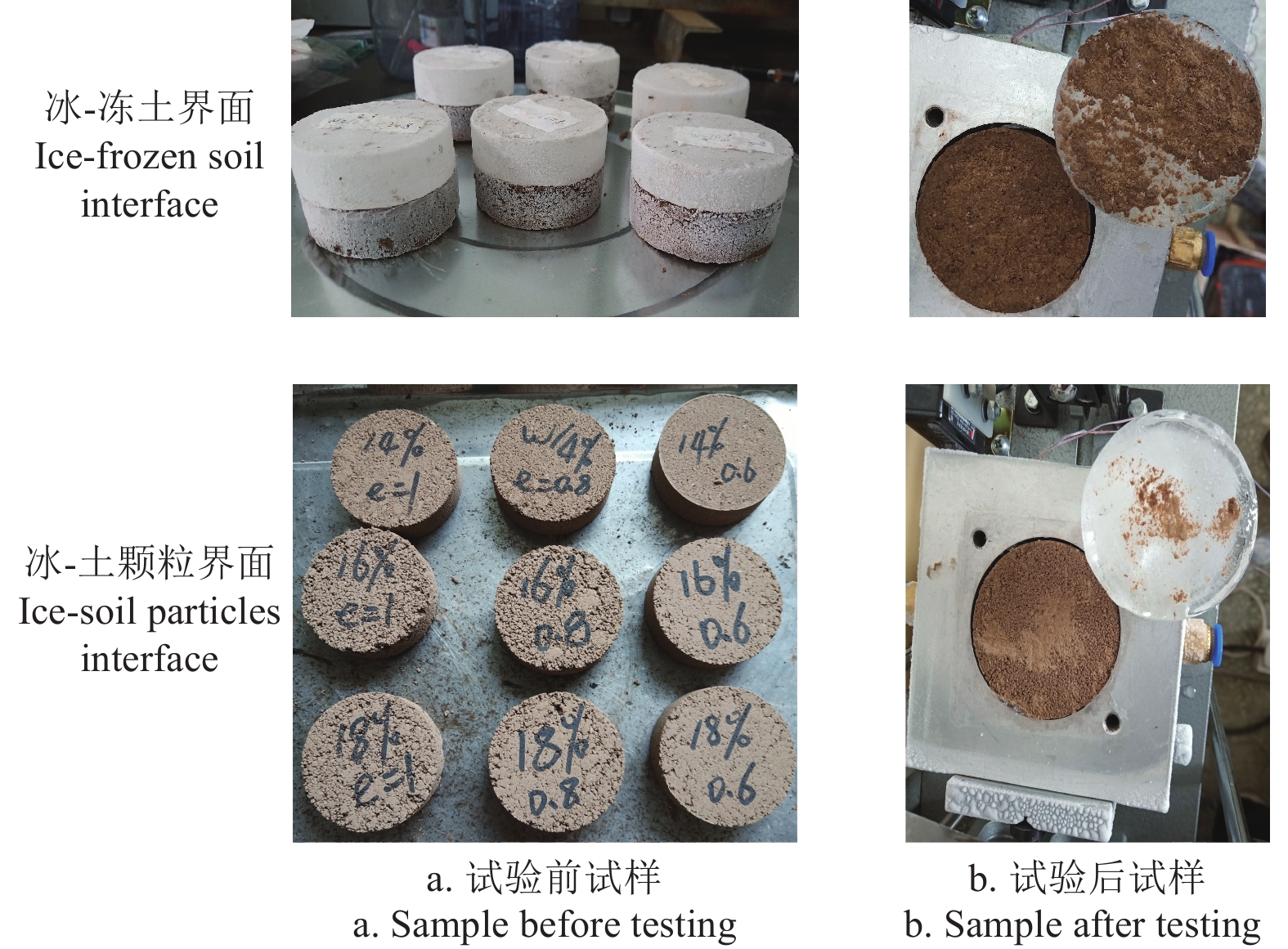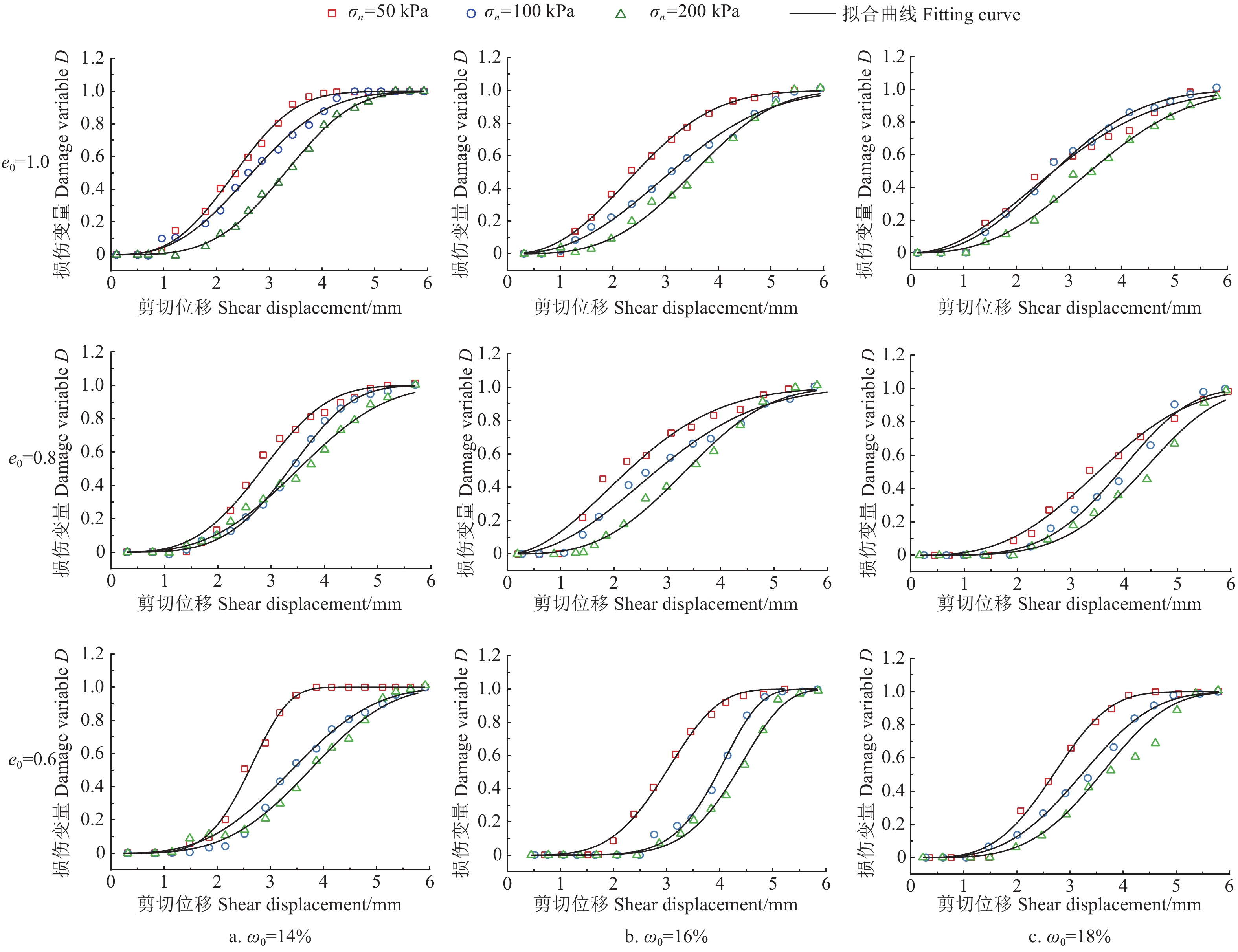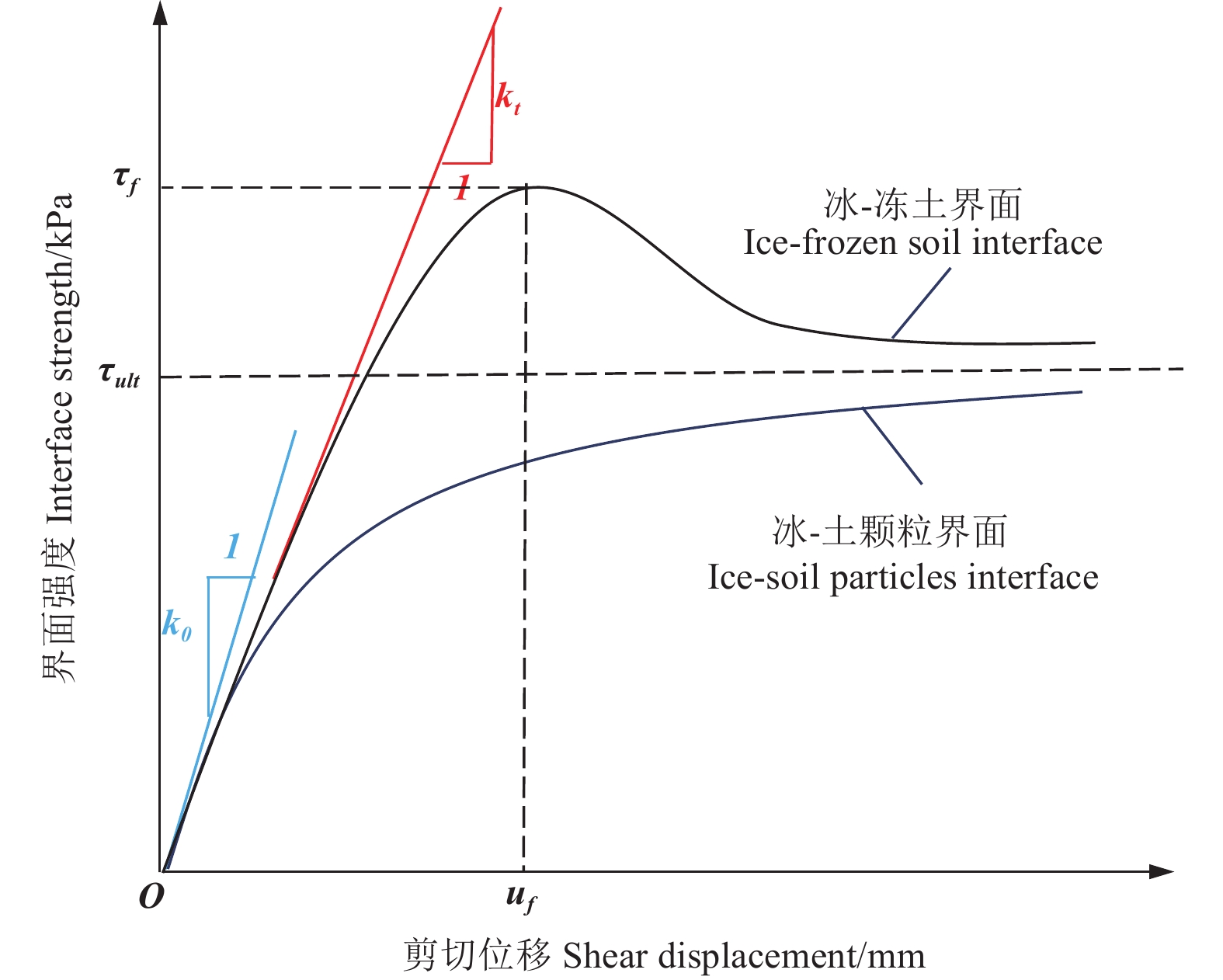Mechanical properties of ice-frozen soil interface under cementation of ice crystals
-
摘要:
寒区多年冻土斜坡内部存在的下卧冰层对多年冻土斜坡稳定有着重要影响。为探究冰-冻土界面力学特性对斜坡稳定的影响,该研究以冰-冻土界面为研究对象,在低温环境(−3 ℃)下开展了不同冻土初始孔隙比和含水率下的冰-冻土界面及对应的冰-土颗粒界面直接剪切试验,建立了考虑冰晶胶结特性的冰-冻土界面非线性弹性损伤模型,结合试验结果对模型进行了验证,并分析了界面在剪切过程中切线刚度的变化规律。结果表明:冰-土颗粒界面的剪切应力表现为应变硬化特性,而冰-冻土界面的剪应力在峰值强度之后迅速下降,表现为应变软化特性。冰-冻土界面结构系数峰值点对应的剪切位移随着含水率的增大而增大,当冻土初始孔隙比为1.0、0.8和0.6,冻土初始含水率从14%增大至18%时剪切位移分别增大了32.7%、41.3%和52.1%。在−3 ℃下,冻土的初始含水率越大,则界面处的胶结冰越多,黏聚强度对界面的抗剪强度贡献也就越大。当结构系数达峰值点后,界面开始产生损伤,并随着剪切位移的增加进入加速损伤阶段。剪切过程中界面的切线刚度呈先增大后减小的趋势,在结构系数峰值点处为0,之后切线刚度随着剪切位移的增加逐渐减小。此外,界面的峰值切线刚度随着法向应力的增大而增大,当冻土初始孔隙比1.0、初始含水率为18%,法向应力从50 kPa增大至200 kPa时,则界面的峰值切线刚度增加了63.7%。在冰-冻土界面力学模型中考虑冰晶胶结特性更加合理,研究结果可为寒区斜坡稳定性分析提供参考。
Abstract:Water migration often occurs in the permafrost slopes during seasonal variations. The water can be accumulated in the vicinity of the freezing front, and then congealed into ice, due to the influence of gravitational and temperature fields. The underlying ice layer was gradually formed with the increase of ice thickness and area. The interface between the ice layer and the overlying frozen soil can play a crucial role in the stability of the permafrost slope. The mechanical behaviors of ice-frozen soil interface can provide the theoretical support for the stability assessment of permafrost slopes over the long term. This research aims to investigate the mechanical properties of the ice-frozen soil interface. A series of direct shear tests were conducted under the temperature of −3 ℃. The shear stresses of the ice-frozen soil interface and the ice-soil particles interface were investigated under different normal stresses, initial water contents, and initial void ratios of the frozen soil. The experimental results showed that the shear stress of the ice-soil particles interface exhibited the hardening behavior, and then increased with the decreasing void ratio of the frozen soil. Softening behavior was found in the shear stress of the ice-frozen soil interface, particularly under lower normal stresses. The shear stress also increased with the increasing initial water content of the frozen soil. The structural coefficient, damage variable, and structural strength of the ice-frozen soil interface were defined, according to the mechanical properties and the failure evolution of the ice-soil particles interface and ice-frozen soil interface. There was an increase in the shear displacement corresponding to the structural coefficient peak point of the ice-frozen soil interface with the increase of initial water content. Furthermore, the initial water content of frozen soil increased from 14% to 18%, while the shear displacement increased by 32.7%, 41.3%, and 52.1%, respectively, when the initial void ratios of frozen soil was 1.0, 0.8, and 0.6. A nonlinear elastic damage model was established to consider the bonding characteristics of ice crystals at the ice-frozen soil interface using the Duncan-Chang model, where the tangent stiffness was obtained. The calculation results demonstrate that the shear stress curve suddenly decreased after reaching the peak strength under low normal stress, when the ice content at the interface was high, indicating the noticeable brittleness interface. The mechanical properties of the ice–frozen soil interface shifted gradually from brittleness to plasticity, as the normal stress increased. There was the significant decrease in the magnitude of the shear stress after the peak strength. Therefore, the inhibitory effect of the increasing normal stress on the brittleness failure of the ice-frozen soil interface. The calculation was matched better with the experimental before the peak shear stress. By contrast, the decrease rate of the calculated shear stress curve was significantly lower than the experimental after the peak strength. The tangent stiffness of the interface increased with the increase of normal stress under the same initial void ratio and water content of the frozen soil. The normal stress increased from 50 to 200 kPa, while the tangential stiffness peak point of the interface increased by 63.7%, when the initial void ratio and water content of frozen soil were 1.0, and 18%, respectively. The increasing normal stress was induced a shear movement of soil particles at the ice-frozen soil interface, thus promoting the pore healing and strengthening the interface. Conversely, once the normal stresses were the same, the tangent stiffness of the interface increased with the increase of initial water content of the frozen soil, as the shear displacement was smaller than u0. While the shear displacement was larger than u0, the tangent stiffness gradually decreased with the increase of shear displacement and approaches zero.
-
0. 引 言
在多年冻土斜坡的结构中,上部为夏融冬冻的活动层,而下部为永冻层。季节交替时活动层中的水分在重力场和温度场作用下向冻结锋面迁移并集聚成冰,经过长期的积累之后,在冻土斜坡内部冻结锋面附近形成一定厚度的下卧冰层,冰层与上部活动层之间的界面对多年冻土斜坡的稳定有着重要的影响[1-3]。近年来,随着国家战略的纵深发展,多年冻土地区的基础设施建设迎来新的发展机遇。然而由于气候变暖造成的冻土环境升温导致的春融时期冻土斜坡失稳频频发生,这对寒区工程建设及安全运营有着重要影响。明确寒区多年冻土斜坡的失稳机理,是冻土工程界多年来一个悬而未决的问题[4-6]。
诱发寒区多年冻土斜坡失稳的主要因素可归纳为两类,第1类是由于冻融作用导致斜坡浅层土体强度的下降而引发的热融滑塌;第2类是由于斜坡坡脚的工程开挖而诱发上部活动层沿着冰-土界面产生滑动[7-8]。因此,对多年冻土斜坡的稳定性进行分析评价的关键在于准确判断斜坡变形特征及滑动面的位置,然后通过室内试验确定滑动面的力学参数并结合理论计算来判断斜坡的稳定性[9-10]。对于多年冻土斜坡变形破坏特征的研究,目前最有效的手段是现场监测,监测的内容主要包括斜坡的变形量、斜坡土体的温度及含水率的变化,然后基于监测结果对多年冻土斜坡的变形破坏进行评价[11]。多年冻土斜坡的变形破坏不仅与滑带土的强度参数相关,还与融化固结过程中滑动面的超静孔隙水压力有关[12-14]。因此,冻土斜坡的稳定性研究不仅包括滑带土体在冻融循环作用之后的强度特性和流变特性,还有斜坡滑动面的剪切特性[15-16]。对于冰-冻土界面的剪切特性,SHI等[17]针对冰-冻土界面进行了一系列直剪试验,得到了不同温度下界面的强度参数,分析了温度、冻土初始含水率和初始孔隙比对界面强度的影响。此外,一些学者也对冻土-结构界面进行了试验研究,分析了温度[18-20]、法向应力[21]、冻土初始含水率、界面粗糙度和冻融循环次数对界面强度的影响[22-23],并根据界面的剪切行为建立了相应的力学模型[24-25]。NIU等[26]对青藏铁路周边的冻土斜坡进行了地质勘察,发现斜坡活动层的下部分布着厚度为0.5~0.8 m不等的冰层。受外界工程活动及四季交替时温度的影响,斜坡将沿着冰-冻土界面产生滑动。为了研究上覆活动层与下卧冰层之间界面的力学特性,采取现场试验研究了冰-冻土界面的力学特性,获得了界面的强度参数,之后对斜坡的稳定性进行了分析。目前对冻土-结构界面的力学特性及模型研究较多,然而冰-冻土界面的力学特性及考虑冰晶胶结对界面强度影响的研究目前鲜有文献进行报道。
为了深入理解多年冻土斜坡内部冰-冻土界面的力学特性,本文以冰-冻土界面为研究对象,进行不同条件下的直剪试验,分析不同因素对界面强度的影响,根据冰晶胶结影响定义界面的结构特性,建立考虑冰晶胶结影响的冰-冻土界面非线性弹性损伤模型,并对界面切线刚度及影响因素进行分析。
1. 试验材料与方法
1.1 试样制备
试验土样取自黑龙江省大兴安岭地区某多年冻土斜坡,试验前,首先将晾干的土样碾碎后过5 mm的筛子。然后按照《公路土工试验规程》(JTG E40-2007)进行常规物理参数试验,结果见表1。
表 1 土的基本物理指标Table 1. Physical parameters of the soil土粒密度
Soil particle density/
(g·cm−3)天然含水率
Natural water
content /%天然密度
Natural density/
(g·cm−3)塑限
Plastic limit/
%液限
Liquid limit/
%2.75 15.30 1.62 25.19 36.98 根据现场地质勘察,研究区多年冻土斜坡活动层的天然含水率为15.30%,天然孔隙比为0.73。为了模拟多年冻土斜坡活动层的密实度和含水率对滑动面力学特性的影响,该研究设计的试样初始含水率和初始孔隙比覆盖了根据勘察得到的冻土天然含水率和天然孔隙比,且具有一定的增长梯度。因此采用初始孔隙比为1.0、0.8和0.6,初始含水率为14%、16%和18%的冻土试样制备冰-冻土试样来进行界面直剪试验。试件的冰样采用高为20 mm,直径为61.8 mm的环刀来制备。首先,将环刀放置在底部平整的托盘中,在内部注入蒸馏水后置于温度为−20 ℃的环境中冻结24 h,冻结完成后刮平环刀上部冻结膨胀的部分后在−3 ℃的环境中12 h。接着,将内部涂有凡士林的另一个同样大小的环刀和装有冰样的环刀固定在一起,将预先制备好的土样采用控制干密度的方法分层置于环刀内部压实。然后用保鲜膜裹住整个试样后置于−20 ℃的环境中冻结24 h。脱模后将试样置于−3 ℃的试验环境中24 h后放入温控剪切盒内进行试验。
另外,为了模拟冰与土颗粒之间的摩擦特性,本文还设计了冰-土颗粒界面的直剪试验。首先按照上述方法把冰样制备好并脱模后置于试验温度环境中24 h。然后在高20 mm,直径为61.8 mm的环刀中按照预先设计的孔隙比将土样采用控制干密度的方法分层置于环刀中压实。接着将土样置于108 ℃的环境中24 h以上确保试样中的水分全部蒸发。最后将脱水的土样脱模后放入固定好的下剪切盒中,再将冰样放入上剪切盒,即可进行冰-土颗粒界面的直剪试验。
1.2 试验过程
试验在改进的低温直剪装置中进行,如图1所示。
为了保证试验过程中环境温度的准确性,试验中分别在剪切盒底部和试样界面处插入热电偶来跟踪温度。在剪切装置右侧安装应力传感器和位移传感器来监测试验过程中的水平应力和位移。位移传感器的精度为0.001 mm,应力传感器的精度为0.001 N。在试验过程中首先将试样装入目标温度的剪切盒,当热电偶监测的试样内部的温度波动为±0.1 ℃时,冰-冻土界面温度场趋于稳定。然后垂直方向进行加载,并打开伺服电机开始剪切。根据现场监测资料,冻土斜坡地表1 m以下土体的温度为−2~−3 ℃,斜坡下卧冰层分布在地表以下3~10 m的深度范围内,由于土体天然密度为1.62 g/cm3,上覆应力最小值为50 kPa, 为了模拟上覆压力和温度对界面剪切特性的影响,试验中法向应力分别设置为50、100、200 kPa,试验环境温度设置为−3 ℃,根据《公路土工试验规程》,采用快剪试验,且剪切速度设置为0.8 mm/min。
2. 试验结果与分析
不同初始孔隙比和初始含水率的冻土试样制备而成的冰-冻土界面剪应力-剪切位移与对应脱水土样制备而成的冰-土颗粒界面剪应力-剪切位移曲线见图2。从图中可以看出,冰-冻土界面剪应力在峰值点前随着剪切位移的增大而增大。当剪应力越过峰值点后随着剪切位移的增大而减小,最后趋于平稳,剪应力在峰值点之后表现为软化特性。冰-土颗粒界面在剪切过程中剪应力不存在峰值点,剪应力曲线为典型的双曲线,随着剪切位移的增加,剪应力达到最大值后便趋于平稳。整体上看,当剪应力达到稳定后冰-土颗粒界面的剪切力均低于冰-冻土界面的剪应力,这说明冰-冻土界面处胶结冰完全破损后的抗剪强度仍然大于冰-土颗粒界面,这是由于界面处胶结冰破损之后,破碎冰颗粒与冰之间的摩擦导致。
![]() 图 2 不同法向应力下冰-冻土界面和冰-土颗粒界面的剪应力曲线注:e0为冻土的初始孔隙比;ω0为冻土的初始含水率,%;σn为法向应力,kPa。Figure 2. Shear stress curves of ice-frozen soil interface and ice-soil particles interface under different normal stressesNote:e0 is the initial void ratio of frozen soil; ω0 is the initial water content of frozen soil, %; σn is the normal stress, kPa.
图 2 不同法向应力下冰-冻土界面和冰-土颗粒界面的剪应力曲线注:e0为冻土的初始孔隙比;ω0为冻土的初始含水率,%;σn为法向应力,kPa。Figure 2. Shear stress curves of ice-frozen soil interface and ice-soil particles interface under different normal stressesNote:e0 is the initial void ratio of frozen soil; ω0 is the initial water content of frozen soil, %; σn is the normal stress, kPa.在相同的法向应力下,冰-冻土界面的软化特性代表了界面处冰晶的胶结特性,胶结力越大,剪应力曲线的软化特性越明显。当冻土初始孔隙比较高(e0=1.0),法向应力较小时(σn=50 kPa),界面剪应力表现出明显的软化特性。而当冻土初始孔隙较低(e0=0.6),法向应力较大时,界面的软化特性不明显,当剪应力达到峰值时,界面开始破坏,随着剪切位移的增加,界面损伤不断累积,直至完全破坏,最终剪应力与冰-土颗粒界面剪应力接近。以上为根据界面剪应力的变化特点对冰-冻土界面和冰-土颗粒界面的力学特性进行了分析,分了更直观的比较二者之间的区别,下面对试验前后冰-冻土界面和冰-土颗粒界面的特征图进行分析。
图3为试验前后两类界面的特征图,从图中可以看出,冰-冻土界面在剪切过程中由于界面处冰晶的胶结作用,冰与冻土之间的破坏面不一定位于二者的几何界面处,而是位于界面附近具有一定厚度的冻土中。冰-土颗粒界面在剪切过程中不受胶结冰的影响,滑动沿着冰与脱水土样之间的几何界面处产生,其界面强度也主要是由冰与土颗粒的摩擦提供。
3. 冰-冻土界面非线性弹性损伤模型的建立
对于冻土材料,其抗剪强度主要由黏聚强度和摩擦强度组成,而且二者在受力过程中发挥着不同的作用。在加载初期,黏聚强度发挥主要作用,随着应变的增加,土颗粒与冰晶之间的胶结发生破坏,黏聚强度对抗剪强度的贡献逐渐减小。由于黏聚强度的降低,摩擦强度随着应变的增加逐渐开始对抗剪强度发挥关键作用。冰-冻土界面主要由土颗粒、冰晶和未冻水三部分组成,界面在剪切过程中的抗剪强度也类似于冻土,主要由界面处冰晶的黏聚强度和冰与土颗粒之间的摩擦强度组成。
冰-冻土界面在剪切过程中黏聚强度与摩擦强度的组成示意图及界面的力学响应如图4所示。
![]() 图 4 剪切荷载作用下冰-冻土界面强度组成及应力响应注:τ0和u0分别为屈服强度(kPa)和对应的剪切位移(mm); τf和uf分别为峰值强度(kPa)和对应的剪切位移(mm); τc和uc分别为残余强度(kPa)和对应的剪切位移(mm)。Figure 4. Strength composition and stress response of ice-frozen soil interface under shear loadingNote: τ0 and u0 are the yield strength (kPa) and corresponding shear displacement (mm); τf and uf are the peak strength (kPa)and corresponding shear displacement (mm); τc and uc are residual strength (kPa) and corresponding shear displacement (mm).
图 4 剪切荷载作用下冰-冻土界面强度组成及应力响应注:τ0和u0分别为屈服强度(kPa)和对应的剪切位移(mm); τf和uf分别为峰值强度(kPa)和对应的剪切位移(mm); τc和uc分别为残余强度(kPa)和对应的剪切位移(mm)。Figure 4. Strength composition and stress response of ice-frozen soil interface under shear loadingNote: τ0 and u0 are the yield strength (kPa) and corresponding shear displacement (mm); τf and uf are the peak strength (kPa)and corresponding shear displacement (mm); τc and uc are residual strength (kPa) and corresponding shear displacement (mm).从图4中可以看出,荷载作用初期界面的黏聚强度发挥主要作用,剪应力表现为线性特性;当界面处的胶结冰产生损伤之后,黏聚强度减小,摩擦强度逐渐发挥作用,剪应力表现为非线性特性;当剪应力越过峰值之后,界面黏聚强度基本丧失,摩擦强度发挥主要作用,剪应力表现为软化特性并逐渐趋于稳定。当0<u<u0时,界面未产生损伤,抗剪强度主要由胶结冰的黏聚强度承担;当u0<u<uc时,界面处胶结冰开始产生损伤,此时界面抗剪强度由黏聚强度与摩擦强度共同承担,且这个过程中黏聚强度对界面的贡献逐渐减小,而摩擦强度的贡献逐渐增大;当u>uc时,界面处的胶结冰完全破损,抗剪强度主要由摩擦强度承担。因此冰-冻土界面在剪切过程中强度的演化主要是黏聚强度、摩擦强度及其二者耦合作用的结果。
3.1 界面参数分析
冰-冻土界面的结构性可以通过界面在荷载作用下破坏前后的强度变化来定量的反映。当界面处胶结冰完全破损后,界面的摩擦强度同样会受到未冻水和破碎冰颗粒的影响。相比于冰晶的胶结作用和冰与土颗粒之间的摩擦作用,二者对界面强度的影响较小。为了简化计算,该研究忽略这两个因素对界面强度的影响。从冰-冻土界面与对应的冰-土颗粒界面之间的剪应力差异来分析界面的结构特性[27]。从图4中可以看出,冰-冻土界面的峰值剪应力越大,则界面的黏聚强度越大;而冰-土颗粒界面剪应力趋于稳定后的值越大,则界面的摩擦强度越大。总体上当剪切位移相同时,冰-冻土界面的剪应力均大于对应的冰-土颗粒界面的剪应力。因此可以用相同剪切位移下冰-冻土界面和冰-土颗粒界面的剪应力之比来定义界面的结构系数m,可表示为
m=τi/τiτdτd (1) 式中τi、τd分别为相同剪切位移下冰-冻土界面的剪应力和对应的冰-土颗粒界面的剪应力,kPa。
根据冰-冻土界面和冰-土颗粒界面的剪应力试验结果,利用式(1)可以计算得到不同剪切位移下冰-冻土界面的结构系数m。结合图4界面剪应力的变化规律,可以得到界面结构系数m与界面剪应力之间的对应关系,如图5所示。
![]() 图 5 界面剪应力与结构系数之间的关系注:k0为冰-冻土界面的初始切线刚度, kPa·m−1;m0为结构系数峰值点,mc为结构系数稳定点;图中冻土的初始孔隙比为1.0、初始含水率为14%、法向应力为100 kPa。Figure 5. Relationship between the shear stress and interface structure coefficientNote: k0 is the initial tangent stiffness of the ice frozen soil interface, kPa·m−1; m0 is the peak point of the structure coefficient, mc is the stable point of the structure coefficient; in this figure, the initial void ratio of frozen soil is 1.0, initial water content is 14% and the normal stress is 100 kPa.
图 5 界面剪应力与结构系数之间的关系注:k0为冰-冻土界面的初始切线刚度, kPa·m−1;m0为结构系数峰值点,mc为结构系数稳定点;图中冻土的初始孔隙比为1.0、初始含水率为14%、法向应力为100 kPa。Figure 5. Relationship between the shear stress and interface structure coefficientNote: k0 is the initial tangent stiffness of the ice frozen soil interface, kPa·m−1; m0 is the peak point of the structure coefficient, mc is the stable point of the structure coefficient; in this figure, the initial void ratio of frozen soil is 1.0, initial water content is 14% and the normal stress is 100 kPa.从图5中可以看出,界面结构系数的峰值点m0对应的界面剪应力为屈服强度。而结构系数趋于稳定的点mc对应的界面剪应力为残余强度。二者与剪切位移的交点分别为u0和uc。为了准确确定u0和uc,首先对结构系数m采用广义双曲线模型进行拟合,双曲线形式为
m=u(α+χu)(α+βu)2 (2) 式中α、β、χ分别为模型参数。
采用双曲线模型拟合的界面结构系数如图6所示。从图中可以看出,当u<u0时,冰-冻土界面冰晶的胶结没有产生损伤,随着剪位移的增加,黏聚强度发挥主要作用,结构系数呈上升趋势。达到峰值点时,对应的剪切位移为u0,当u>u0时,结构系数随着剪切位移的增加快速下降,最后趋于平稳。在这个过程中,冰-冻土界面胶结逐渐破坏直至黏聚强度完全丧失。当初始孔隙比为1.0、初始含水率为16%、法向应力为50 kPa时界面结构系数m下降速率较大,这是由于该条件下界面处冰晶含量较大,法向应力较小时黏聚强度发挥主要作用,当冰晶的胶结破损之后,界面结构特性迅速丧失。根据界面结构结构系数峰值点和趋于稳定的点可以确定出u0和uc,如表2所示。可以看出,当冻土初始孔隙比为1.0时,冻土初始含水率为14%、16%和18%时,对应的u0分别为0.8、1.0和1.2 mm;当冻土初始孔隙比为0.8时,3种冻土初始含水率对应的u0分别为1.2、1.5和1.9 mm;当冻土初始孔隙比为0.6时,3种冻土初始含水率对应的u0分别为1.3、2.0和1.5 mm。当冻土初始孔隙比分别为1.0、0.8和0.6时,冻土初始含水率从14%增大至18%时对应的u0分别增大32.7%、41.3%和52.1%。可以看出随着含水率的增大,u0也呈增大的趋势,这是由于温度相同(−3 ℃)时,冻土的初始含水率越大,则界面处的胶结冰越多,黏聚强度对界面的抗剪强度贡献也就越大。
此外,从界面结构系数变化规律可以得到荷载作用下界面的损伤变量D。当u<u0时,结构系数呈线性增大趋势,这是由于此时冰-冻土界面处于相对完整状态,结构未产生破坏,界面的黏聚强度发挥主导作用。当u>u0时,界面结构系数随着剪切位移的增长而迅速减小,最后趋于稳定,对应的剪切位移为uc。该过程中冰-冻土界面的结构产生破坏并逐步丧失,直至冰与土颗粒之间的摩擦特性完全发挥出来。在这个过程中,界面的损伤从u0开始,直至uc终止,对应的损伤变量D可表示为
D=uc(u−u0)u(uc−u0) (3) 式中u为试验过程中界面开始产生损伤后的剪切位移,mm。
结合式(3)和表2,可以计算出冰-冻土界面在剪切过程中的损伤变量D。界面损伤变量D与剪切位移u之间的关系可采用双参数Weibull分布模型来描述,模型表达式为
D=1−exp(−a⋅ub) (4) 式中a、b分别为模型参数。
采用式(4)对损伤变量的拟合如图7所示,拟合参数见表3。从图中可以看出,在剪切过程中当剪切位移小于1 mm时界面没有产生损伤,当u接近u0时,界面开始产生损伤,剪切位移在1~2 mm的范围内损伤较小。而当剪切位移大于2 mm时,随着剪切位移的增加,界面损伤进入加速阶段。一旦冰-冻土界面结构完全丧失,损伤变量D的增长速率降低并趋于0,而且D的值趋近于1。
表 2 界面结构系数峰值点和稳定点对应的剪切位移Table 2. Shear displacement corresponding to peak and stable points of interface structure coefficientmm 初始含水率
Initial water
content/%初始孔隙比
Initial void
ratiou0 uc 50 kPa 100 kPa 200 kPa 50 kPa 100 kPa 200 kPa 14 1.0 0.92 0.93 1.26 3.56 4.21 4.33 0.8 2.15 1.93 2.01 5.21 4.56 4.62 0.6 1.96 2.13 2.15 3.57 5.15 5.28 16 1.0 1.17 1.26 1.23 4.58 5.63 5.52 0.8 1.34 2.15 1.48 2.55 5.16 3.16 0.6 3.14 2.97 2.51 5.14 5.07 4.58 18 1.0 1.26 1.35 0.98 5.31 5.67 5.41 0.8 1.56 1.76 2.14 5.23 5.64 5.52 0.6 1.98 2.15 2.26 5.33 5.28 5.10 表 3 损伤变量模型的拟合参数Table 3. Fitting parameters of damage variable model初始含水率
Initial water
content/%初始孔隙比
Initial void
ratioa b 50 kPa 100 kPa 200 kPa 50 kPa 100 kPa 200 kPa 14 1.0 0.055 0.047 0.008 2.74 2.98 3.70 0.8 0.020 0.005 0.013 3.39 4.12 3.15 0.6 0.006 0.006 0.014 4.96 3.79 3.18 16 1.0 0.082 0.043 0.010 2.4 2.46 3.44 0.8 0.143 0.077 0.016 1.94 2.14 3.13 0.6 0.006 0.0044 0.004 4.35 7.01 6.62 18 1.0 0.090 0.064 0.027 2.05 2.39 2.65 0.8 0.016 0.002 0.001 3.00 4.26 4.36 0.6 0.018 0.011 0.004 3.67 3.47 4.01 注:a、b为损伤模型参数,可根据试验结果拟合得到。 Note: a, b are the damage model parameters, and can be obtained by fitting the experimental results. 3.2 界面模型的建立
如图8所示,对于冰-土颗粒界面,由于界面处无冰晶的胶结作用,界面抗剪强度主要由冰与土颗粒的摩擦强度提供,剪应力呈双曲线形式,可采用Duncan-Chang模型来描述其力学行为。而对于冰-冻土界面,由于冰晶的胶结作用使界面表现出结构性,其抗剪强度主要由冰晶的黏聚强度和冰与土颗粒的摩擦强度提供,峰值强度之后剪应力逐渐减小并趋于稳定。对于冰-冻土界面,要确定界面的剪应力时需要考虑结构特性的影响,因此无法直接利用Duncan-Chang模型来描述冰-冻土界面的力学行为。为此,本节以Duncan-Chang模型为基础,通过引入结构强度来计算考虑冰晶胶结影响的冰-冻土界面剪应力。
![]() 图 8 冰-冻土界面和冰-土颗粒界面剪应力变化示意图注:τf 和uf为冰-冻土界面的峰值强度(kPa)和对应的剪切位移(mm); τult为冰-土颗粒界面曲线渐近线对应的强度,kPa; kt为冰-冻土界面任意点处的切线刚度, kPa·m−1。Figure 8. Schematic diagram of shear stress variation for ice-frozen soil interface and ice-soil particles interfaceNote: τf and uf are the peak strength (kPa) and corresponding shear displacement of the ice-frozen soil interface (mm); τultis the strength corresponding to asymptote of ice-soil particles interface curve, kPa; kt is the tangent stiffness at any point of the ice-frozen soil interface, kPa·m−1.
图 8 冰-冻土界面和冰-土颗粒界面剪应力变化示意图注:τf 和uf为冰-冻土界面的峰值强度(kPa)和对应的剪切位移(mm); τult为冰-土颗粒界面曲线渐近线对应的强度,kPa; kt为冰-冻土界面任意点处的切线刚度, kPa·m−1。Figure 8. Schematic diagram of shear stress variation for ice-frozen soil interface and ice-soil particles interfaceNote: τf and uf are the peak strength (kPa) and corresponding shear displacement of the ice-frozen soil interface (mm); τultis the strength corresponding to asymptote of ice-soil particles interface curve, kPa; kt is the tangent stiffness at any point of the ice-frozen soil interface, kPa·m−1.由图8可知,冰-土颗粒界面的τd−u关系呈双曲线形态,剪应力与剪位移之间的关系可用Duncan-Chang模型来描述,即
τd=uη+ιu (5) 其中
k0=1/1ηητult=1/1ιι} (6) 式中k0为界面的初始切线刚度,kPa/m;τult为双曲线的渐近线对应的剪应力,kPa;η、ι 为Duncan-Chang模型参数。
由式(6)可知,Duncan-Chang模型参数可采用冰-土颗粒界面的初始切线刚度和渐近线对应的剪应力来计算,由于基于试验结果确定界面初始切线刚度和渐近线时人为主观性较强,进而计算得到的Duncan-Chang模型参数准确性较低。为此,本研究根据文献 [28]中的计算方法,采用抗剪强度的95%和70%的试验数据来确定参数η和ι,即
ι=1τult=(uτ)95%−(uτ)70%(u)95%−(u)70% (7) η=1k0=(uτ)95%+(uτ)70%2−1τult[(u)95%+(u)70%]2 (8) 将冰-土颗粒界面的试验结果代入式(7)和(8)可以得到不同初始孔隙比和法向应力下η和ι的值,见表4。
表 4 Duncan-Chang的模型参数Table 4. Parameters of Duncan-Chang modele0 σn / kPa η ι 1.0 50 0.0178 0.0088 100 0.0098 0.0067 200 0.0063 0.0054 0.8 50 0.0133 0.0093 100 0.0054 0.0048 200 0.0051 0.0033 0.6 50 0.011 0.0075 100 0.0071 0.0051 200 0.0039 0.0031 注:η、ι为Duncan-Chang模型参数,可根据试验结果计算得到。 Note: η, ι are the Duncan-Chang model parameters, and can be calculated based on the experimental results. 由于界面处冰晶的胶结作用使冰-冻土界面具有一定的结构性,因此冰-冻土界面的τc−u关系曲线表现为软化特性。为了将结构系数m和损伤变量D引入到冰-冻土界面的力学模型中,首先建立二者之间的关系,可表示为
m=m0(1−D)+mcD (9) 为了表针冰-冻土界面剪切过程中冰晶的胶结作用,该研究定义了结构强度κ,其计算式如下
κ=[m0(1−D)+mcD]/[m0(1−D)+mcD](m0−mc)(m0−mc) (10) 将式(4)~(5)和式(9)~(10)分别代入式(1),可得考虑冰晶胶结影响的冰-冻土界面剪应力的表达式
τi=κ(m0−mc)uη+ιu (11) 从式(11)中可以看出冰-冻土界面的剪应力是由冰-土颗粒界面剪应力和结构系数及结构强度组成,由此可见在冰-土颗粒界面的双曲线模型中引入结构系数m和结构强度κ,就可以转化为描述考虑冰晶胶结影响的冰-冻土界面力学模型。为了验证本文提出的冰-冻土界面非线性弹性损伤模型的合理性,将表(2)~(4)中的模型参数代入式(11)可计算出不同法向应力、冻土初始孔隙比和冻土初始含水率下的冰-冻土界面剪应力-剪切位移关系,并将模型计算结果和试验结果进行比较,如图9所示。可以看出本文提出的界面非线性弹性损伤模型能够描述界面在不同条件下的力学特性。当界面处的含冰量较大时,在低法向应力下界面表现出明显的脆性,剪应力曲线在达到峰值强度后突然下降。而随着法向应力的增大,界面的力学特性从脆性逐渐过渡到塑性,剪应力曲线在达到峰值强度后下降幅度明显降低。因此法向应力的增大对界面的脆性破坏具有明显的抑制作用。对比模型计算结果和试验结果可以发现,模型的计算结果在剪应力达到峰值强度之前与试验结果吻合良好,然而达到峰值强度后,模型计算的剪应力曲线下降速率明显小于试验结果,说明本文模型在描述界面的脆性方面仍有一些局限性,这是由于本研究定义的损伤变量D对峰值强度之后剪应力的折减效应有限,而且未考虑法向应力对损伤变量的影响,后续需要进一步对损伤变量进行修正,使模型能够更好地描述界面在峰值强度之后的脆性特性。
4. 冰-冻土界面切线刚度的分析
冰-冻土界面作为冻土和冰之间的第3种介质,其强度低于冰和冻土的强度,作为冻土内部结构的薄弱环节,对冻土的破坏路径和力学特性有显著的影响。界面的切线刚度用于评估冰-冻土界面在一定应力条件下的抗变形能力,是多年冻土斜坡有限元计算中的一个重要参数。界面的切线刚度与剪应力水平有关,由于界面的剪应力曲线在峰值强度之后表现为软化特性,因此界面的切线刚度随着剪应力的变化而变化,不是一个恒定的值。
由于冰晶的胶结作用,冰-冻土界面软化模型中的一些参数很难确定,特别是界面任意点的切线刚度。然而,通过式(11)就可以比较容易的计算出冰-冻土界面的力学参数。考虑冰晶胶结影响的冰-冻土界面任意点处的切线刚度表达式为
kt=dτidu (12) 将式(11)代入式(12)可得
kt=(m0−mc)[uη+ιudκdu+ηκ(η+ιu)2] (13) 将表(2)~(4)中的参数代入式(13)可以得到不同法向应力、冻土初始孔隙比和冻土初始含水率下对应的冰-冻土界面切线刚度的变化规律,如图10所示。从图中可以看出,当u<u0时,切线刚度呈先增大后减小的趋势,并在u0处为0。当u>u0时,剪应力表现为软化特性,且随着剪切位移的增加逐渐减小。当冻土初始孔隙比1.0、冻土初始含水率为18%、法向应力从50 kPa增至200 kPa时,界面的峰值切线刚度增大63.7%。因此冻土初始孔隙比和冻土初始含水率相同时,法向应力越大,则界面的切线刚度越大。这是由于法向应力增大时,冰-冻土界面处的土颗粒产生孔隙愈合性的剪切错动,界面的强度得以提高。而当法向应力相同时,随着冻土初始孔隙比的减小。当剪切位移小于u0时,切线刚度随着冻土初始含水率的增加而增大。当剪切位移大于u0时,切线刚度随剪切位移的增加而逐渐减小,并趋近于零。其原因是环境温度为−3 ℃时,随着冻土初始含水率的增加,界面处会形成更多的冰晶,增加了冰与土颗粒之间的黏聚强度,导致界面强度和对应的切线刚度增大。然而,当剪切位移大于u0时,界面处胶结冰产生破损,相应的黏聚强度减小,此时界面强度主要由冰与土颗粒之间的摩擦提供。随着剪切位移的进一步增大,界面处胶结冰的黏聚强度逐渐消失,所以切线刚度减小。
在本文的分析中,只是从冰-冻土界面和冰-土颗粒界面剪应力的宏观唯向变化特征分析了冰-冻土界面在荷载作用下的抗剪破坏机理。对于未冻水,冰颗粒的摩擦及冰的变形等方面对界面强度的影响尚不清楚。本文通过研究不同冻土初始孔隙比和初始含水率下冰-冻土与冰-土颗粒界面在不同法向应力下的界面剪应力特性,定义了界面在剪切过程中的结构系数、损伤变量及结构强度。基于经典的Duncan-Chang模型推演出考虑冰晶胶结影响的冰-冻土界面非线性弹性损伤模型,并通过本文的模型可以简便快速地确定出冰-冻土界面的切线刚度。
寒区含冰结构的冻土路基或冻土边坡在荷载作用下的强度与变形特性不仅取决于冻土和冰结构的力学特性,还与它们之间界面的力学特性密切相关。冰-冻土界面作为含冰冻土路基和冻土边坡结构中冻土和冰结构之间的第3种介质,其强度一般低于冻土和冰的强度,作为寒区路基和边坡内部结构的薄弱环节,冰-冻土界面对路基和边坡的变形特性和破坏路径有着显著的影响。目前对含冰结构冻土路基和冻土边坡进行有限元模型计算时只定义了冻土和冰的力学模型,冻土采用弹塑性模型,冰采用弹性模型,而未考虑二者之间界面的力学模型[29-30]。而本研究提出的冰-冻土界面非线性弹性损伤模型,为寒区含冰结构冻土路基和冻土边坡的有限元模型中考虑界面时提供了一种简单可行的力学模型,模型中的参数物理意义明确而且易于确定。考虑冰-冻土界面的含冰结构冻土路基与冻土边坡的有限元模型计算将是本文后续需要推进的工作。
5. 结 论
为了探究寒区多年冻土斜坡内部冰-冻土界面的力学行为,本文进行了一系列不同条件下冰-冻土和冰-土颗粒界面的直剪试验,并基于试验结果提出了考虑冰晶胶结影响的冰-冻土界面非线性弹性损伤模型和切线刚度的确定方法。得出的结论如下:
1)冰-土颗粒界面的剪切应力表现为硬化特性,而冰-冻土界面的剪应力在峰值强度之后迅速下降,表现为软化特性。冰-冻土界面结构系数峰值点对应的剪切位移随着含水率的增大而增大,当冻土初始孔隙比分别为1.0、0.8和0.6,冻土初始含水率从14%增大至18%时剪切位移分别增大了32.7%、41.3%和52.1%。
2)利用冰-冻土界面与冰-土颗粒界面的剪应力之比定义了界面的结构系数,表征了冰-冻土界面处胶结冰产生的结构性强弱。当冻土初始含水率和冻土初始孔隙比相同时,结构系数随着法向应力的减小而增大;当法向应力和冻土初始孔隙比相等时,结构系数随着冻土初始含水率的增大而大幅度的增大。
3)建立了考虑冰晶胶结影响的冰-冻土界面非线性弹性损伤模型,通过试验结果对模型的合理性进行了验证。并基于该模型推导了界面的切线刚度,分析了界面切线刚度与法向应力、冻土初始含水率和冻土初始孔隙比之间的关系。当冻土初始孔隙比为1.0、初始含水率为18%、法向应力从50 kPa增至200 kPa时,界面的峰值切线刚度增大了63.7%。
-
图 2 不同法向应力下冰-冻土界面和冰-土颗粒界面的剪应力曲线
注:e0为冻土的初始孔隙比;ω0为冻土的初始含水率,%;σn为法向应力,kPa。
Figure 2. Shear stress curves of ice-frozen soil interface and ice-soil particles interface under different normal stresses
Note:e0 is the initial void ratio of frozen soil; ω0 is the initial water content of frozen soil, %; σn is the normal stress, kPa.
图 4 剪切荷载作用下冰-冻土界面强度组成及应力响应
注:τ0和u0分别为屈服强度(kPa)和对应的剪切位移(mm); τf和uf分别为峰值强度(kPa)和对应的剪切位移(mm); τc和uc分别为残余强度(kPa)和对应的剪切位移(mm)。
Figure 4. Strength composition and stress response of ice-frozen soil interface under shear loading
Note: τ0 and u0 are the yield strength (kPa) and corresponding shear displacement (mm); τf and uf are the peak strength (kPa)and corresponding shear displacement (mm); τc and uc are residual strength (kPa) and corresponding shear displacement (mm).
图 5 界面剪应力与结构系数之间的关系
注:k0为冰-冻土界面的初始切线刚度, kPa·m−1;m0为结构系数峰值点,mc为结构系数稳定点;图中冻土的初始孔隙比为1.0、初始含水率为14%、法向应力为100 kPa。
Figure 5. Relationship between the shear stress and interface structure coefficient
Note: k0 is the initial tangent stiffness of the ice frozen soil interface, kPa·m−1; m0 is the peak point of the structure coefficient, mc is the stable point of the structure coefficient; in this figure, the initial void ratio of frozen soil is 1.0, initial water content is 14% and the normal stress is 100 kPa.
图 8 冰-冻土界面和冰-土颗粒界面剪应力变化示意图
注:τf 和uf为冰-冻土界面的峰值强度(kPa)和对应的剪切位移(mm); τult为冰-土颗粒界面曲线渐近线对应的强度,kPa; kt为冰-冻土界面任意点处的切线刚度, kPa·m−1。
Figure 8. Schematic diagram of shear stress variation for ice-frozen soil interface and ice-soil particles interface
Note: τf and uf are the peak strength (kPa) and corresponding shear displacement of the ice-frozen soil interface (mm); τultis the strength corresponding to asymptote of ice-soil particles interface curve, kPa; kt is the tangent stiffness at any point of the ice-frozen soil interface, kPa·m−1.
表 1 土的基本物理指标
Table 1 Physical parameters of the soil
土粒密度
Soil particle density/
(g·cm−3)天然含水率
Natural water
content /%天然密度
Natural density/
(g·cm−3)塑限
Plastic limit/
%液限
Liquid limit/
%2.75 15.30 1.62 25.19 36.98 表 2 界面结构系数峰值点和稳定点对应的剪切位移
Table 2 Shear displacement corresponding to peak and stable points of interface structure coefficient
mm 初始含水率
Initial water
content/%初始孔隙比
Initial void
ratiou0 uc 50 kPa 100 kPa 200 kPa 50 kPa 100 kPa 200 kPa 14 1.0 0.92 0.93 1.26 3.56 4.21 4.33 0.8 2.15 1.93 2.01 5.21 4.56 4.62 0.6 1.96 2.13 2.15 3.57 5.15 5.28 16 1.0 1.17 1.26 1.23 4.58 5.63 5.52 0.8 1.34 2.15 1.48 2.55 5.16 3.16 0.6 3.14 2.97 2.51 5.14 5.07 4.58 18 1.0 1.26 1.35 0.98 5.31 5.67 5.41 0.8 1.56 1.76 2.14 5.23 5.64 5.52 0.6 1.98 2.15 2.26 5.33 5.28 5.10 表 3 损伤变量模型的拟合参数
Table 3 Fitting parameters of damage variable model
初始含水率
Initial water
content/%初始孔隙比
Initial void
ratioa b 50 kPa 100 kPa 200 kPa 50 kPa 100 kPa 200 kPa 14 1.0 0.055 0.047 0.008 2.74 2.98 3.70 0.8 0.020 0.005 0.013 3.39 4.12 3.15 0.6 0.006 0.006 0.014 4.96 3.79 3.18 16 1.0 0.082 0.043 0.010 2.4 2.46 3.44 0.8 0.143 0.077 0.016 1.94 2.14 3.13 0.6 0.006 0.0044 0.004 4.35 7.01 6.62 18 1.0 0.090 0.064 0.027 2.05 2.39 2.65 0.8 0.016 0.002 0.001 3.00 4.26 4.36 0.6 0.018 0.011 0.004 3.67 3.47 4.01 注:a、b为损伤模型参数,可根据试验结果拟合得到。 Note: a, b are the damage model parameters, and can be obtained by fitting the experimental results. 表 4 Duncan-Chang的模型参数
Table 4 Parameters of Duncan-Chang model
e0 σn / kPa η ι 1.0 50 0.0178 0.0088 100 0.0098 0.0067 200 0.0063 0.0054 0.8 50 0.0133 0.0093 100 0.0054 0.0048 200 0.0051 0.0033 0.6 50 0.011 0.0075 100 0.0071 0.0051 200 0.0039 0.0031 注:η、ι为Duncan-Chang模型参数,可根据试验结果计算得到。 Note: η, ι are the Duncan-Chang model parameters, and can be calculated based on the experimental results. -
[1] 徐敩祖, 王家澄, 张立新. 冻土物理学[M]. 北京: 科学出版社, 2010: 198-205. [2] 沈宇鹏. 青藏铁路安多段多年冻土斜坡路基稳定性研究[D]. 北京: 北京交通大学, 2007. SHEN Yupeng. Study of Stability of Embankment upon the Slope in the Permafrost Area at Anduo Section of Qinghai-Tibet Railway [D]. Beijing: Beijing Jiaotong University, 2007. (in Chinese with English abstract)
[3] 杨让宏,朱本珍. 青藏铁路多年冻土区斜坡路堤的稳定性分析[J]. 岩土力学,2011,32(7):2117-2122. YANG Ranghong, ZHU Benzhen. Stability analysis of Qinghai-Tibet Railway slope embankment in permafrost regions[J]. Rock and Soil Mechanics, 2011, 32(7): 2117-2122. (in Chinese with English abstract doi: 10.3969/j.issn.1000-7598.2011.07.033 YANG Ranghong, ZHU Benzhen. Stability analysis of Qinghai-Tibet Railway slope embankment in permafrost regions [J]. Rock and Soil Mechanics, 2011, 32 (7): 2117–2122. (in Chinese with English abstract) doi: 10.3969/j.issn.1000-7598.2011.07.033
[4] 冯德成,林波,张锋,等. 冻融作用对土的工程性质影响的研究进展[J]. 中国科学(技术科学),2017,47(2):111-127. FENG Decheng, LIN Bo, ZHANG Feng, et al. A review of freeze-thaw effects on soil geotechnical properties[J]. Scientia Sinica Technologica, 2017, 47(2): 111-127. (in Chinese with English abstract doi: 10.1360/N092016-00224 FENG Decheng, LIN Bo, ZHANG Feng, FENG Xin. A review of freeze-thaw effects on soil geotechnical properties [J]. Scientia Sinica Technologica, 2017, 47(2): 111-127. (in Chinese with English abstract) doi: 10.1360/N092016-00224
[5] 姜龙, 王连俊, 青藏铁路多年冻土区沼泽化斜坡路基稳定性研究[J]. 岩土工程学报, 2008, 30(1): 138–142. JIANG Long, WANG Lianjun. Stability study on swampy sloping roadbed in permafrost regions of Qinghai-Tibet Railway [J]. Chinese Journal of Geotechnical Engineering, 2008, 30(1): 138–142. (in Chinese with English abstract)
[6] 熊治文,廖小平,朱本珍. 多年冻土地区路堑边坡病害及其整治原则[J]. 铁道工程学报,2010,32(4):6-10. XIONG Zhiwen, LIAO Xiaoping, ZHU Benzhen. Disaster of cutting slope in permafrost region and treatment principle[J]. Journal of Railway Engineering Society, 2010, 32(4): 6-10. (in Chinese with English abstract XIONG Zhiwen, LIAO Xiaoping, ZHU Benzhen. Disaster of cutting slope in permafrost region and treatment principle [J]. Journal of Railway Engineering Society, 2010, 32(4): 6–10. (in Chinese with English abstract)
[7] ZHU D Y. A method for locating critical slip surfaces in slope stability analysis[J]. Canadian Geotechnical Journal, 2001, 38(2): 328-337.
[8] NIU F, JING L, LIN Z, et al. Development and thermal regime of a thaw slump in the Qinghai–Tibet plateau[J]. Cold Regions Science and Technology, 2012, 83-84(15): 131-138.
[9] 冯守中, 闫澍旺, 崔琳. 严寒地区路堑边坡破坏机理及稳定计算分析[J]. 岩土力学, 2009, 30(增刊1): 155-159. FENG Shouzhong, YAN Shuwang, CUI Lin. Failure mechanism of highway slope in severe cold area and its stability computation analysis [J]. Rock and Soil Mechanics, 2009, 30 (Supp1): 155-159. (in Chinese with English abstract)
[10] MA W, Niu F J, SATOSHI A, et al. Slope instability phenomena in permafrost regions of Qinghai-Tibet Plateau, China[J]. Landslides, 2006, 3(3): 260–264.
[11] 牛富俊,程国栋,赖远明,等. 青藏高原多年冻土区热融滑塌型斜坡失稳研究[J]. 岩土工程学报,2004,26(3):402-406. NIU Fujun, CHENG Guodong, LAI Yuanming, et al. Instability study on thaw slumping in permafrost regions of Qinghai-Tibet Plateau[J]. China Journal of Geotechnical Engineering, 2004, 26(3): 402-406. (in Chinese with English abstract doi: 10.3321/j.issn:1000-4548.2004.03.021 NIU Fujun, CHENG Guodong, LAI Yuanming , et al. Instability study on thaw slumping in permafrost regions of Qinghai-Tibet Plateau[J] . China Journal of Geotechnical Engineering, 2004, 26(3): 402-406. (in Chinese with English abstract) doi: 10.3321/j.issn:1000-4548.2004.03.021
[12] 靳德武,孙剑锋,付少兰. 青藏高原多年冻土区两类低角度滑坡灾害形成机理探讨[J]. 岩土力学,2005,26(5):774-777. JIN Dewu, SUN Jianfeng, FU Shaolan. Discussion on landslides hazard mechanism of two kinds of low angle slope in permafrost regions of Qinghai-Tibet Plateau[J]. Rock and Soil Mechanics, 2005, 26(5): 774-777. (in Chinese with English abstract doi: 10.3969/j.issn.1000-7598.2005.05.019 JIN Dewu, SUN Jianfeng, FU Shaolan. Discussion on landslides hazard mechanism of two kinds of low angle slope in permafrost regions of Qinghai-Tibet Plateau [J]. Rock and Soil Mechanics, 2005, 26(5): 774-777. (in Chinese with English abstract) doi: 10.3969/j.issn.1000-7598.2005.05.019
[13] NIU F, JING L, LIN Z, et al. Development and thermal regime of a thaw slump in the Qinghai–Tibet plateau[J]. Cold Regions Science & Technology, 2012, 83/84(15): 131-138.
[14] 焦永亮,李韧,赵林,等. 多年冻土区活动层冻融状况及土壤水分运移特征[J]. 冰川冻土,2014,26(2):237-247. JIAO Yongliang, LI Ren, ZHAO Lin, et al. Process of soil thawing-freezing and features of soil moisture migration in the permafrost active layer[J]. Journal of Glaciology and Geocryology, 2014, 26(2): 237-247. (in Chinese with English abstract JIAO Yongliang, LI Ren, ZHAO Lin, et al. Process of soil thawing-freezing and features of soil moisture migration in the permafrost active layer[J]. Journal of Glaciology and Geocryology, 2014, 26(2): 237-247. (in Chinese with English abstract)
[15] 丁靖康,徐学燕,娄安金. 冻融过渡带土的长期抗剪强度[J]. 冰川冻土,1993,15(2):283-288. DING Jingkang, XU Xueyan, LOU Anjin. Long-term shear strength of frost-thaw thansite zone[J]. Journal of Glaciology and Geocryology, 1993, 15(2): 283-288. (in Chinese with English abstract DING Jingkang, XU Xueyan, LOU Anjin. Long-term shear strength of frost-thaw thansite zone[J]. Journal of glaciology and geocryology, 1993, 15(2): 283-288. (in Chinese with English abstract)
[16] 高樯,温智,王大雁,等. 基于冻融交界面直剪试验的冻土斜坡失稳过程研究[J]. 岩土力学,2018,39(8):2814-2822. GAO Qiang, WEN Zhi, WANG Dayan, et al. Study on the instability process of slopes in permafrost regions by direct shear test of freezing-thawing interface[J]. Rock and Soil Mechanics, 2018, 39(8): 2814-2822. (in Chinese with English abstract doi: 10.16285/j.rsm.2016.2552 GAO Qiang, WEN Zhi, WANG Dayan, et al. Study on the instability process of slopes in permafrost regions by direct shear test of freezing-thawing interface [J]. Rock and Soil Mechanics, 2018, 39 (8): 2814-2822. (in Chinese with English abstract) doi: 10.16285/j.rsm.2016.2552
[17] SHI S, ZHANG F, FENG D C, et al. Experimental investigation on shear characteristics of ice–frozen clay interface[J]. Cold Regions Science and Technology, 2020, 176: 103090. doi: 10.1016/j.coldregions.2020.103090
[18] 何鹏飞,马巍,穆彦虎,等. 冻土-混凝土界面冻结强度特征与形成机理研究[J]. 农业工程学报,2018,34(23):128-133. HE Pengfei, MA Wei, MU Yanhu, et al. Study on freezing strength characteristics and formation mechanism of frozen soil-concrete interface[J]. Transactions of the Chinese Society of Agricultural Engineering (Transactions of the CSAE), 2018, 34(23): 128-133. (in Chinese with English abstract HE Pengfei, MA Wei, MU Yanhu, et al. Study on freezing strength characteristics and formation mechanism of frozen soil-concrete interface [J]. Transactions of the Chinese Society of Agricultural Engineering (Transactions of the CSAE), 2018, 34(23): 128-133. (in Chinese with English abstract)
[19] YAZDANI S, HELWANY S, OLGUN G. Influence of temperature on soil-pile interface shear strength[J]. Geomechanics for Energy and the Environment, 2019, 18: 69-78. doi: 10.1016/j.gete.2018.08.001
[20] 朱锐,蔡正银,黄英豪,等. 冻融过程对高寒区渠道基土力学特性的影响[J]. 农业工程学报,2021,37(14):108-116. ZHU Rui, CAI Zhengyin, HUANG Yinghao, et al. Effect of freezing-thawing process on the mechanical properties of canal foundation soils in cold regions[J]. Transactions of the Chinese Society of Agricultural Engineering (Transactions of the CSAE), 2021, 37(14): 108-116. (in Chinese with English abstract doi: 10.11975/j.issn.1002-6819.2021.14.012 ZHU Rui, CAI Zhengyin, HUANG Yinghao, et al. Effect of freezing-thawing process on the mechanical properties of canal foundation soils in cold regions[J]. Transactions of the Chinese Society of Agricultural Engineering (Transactions of the CSAE), 2021, 37(14): 108-116. (in Chinese with English abstract) doi: 10.11975/j.issn.1002-6819.2021.14.012
[21] WANG T, WANG H, HU T, et al. Experimental study on the mechanical properties of soil-structure interface under frozen conditions using an improved roughness algorithm[J]. Cold Regions Science and Technology, 2019, 158: 62-68. doi: 10.1016/j.coldregions.2018.10.015
[22] LIN C, WANG G F, GUAN C, et al. Characteristics of different pile-soil interfaces and the influencing factors[J]. Cold Regions Science and Technology, 2023, 206: 103739. doi: 10.1016/j.coldregions.2022.103739
[23] 葛建锐,王正中,牛永红,等. 冰盖输水衬砌渠道冰冻破 坏统一力学模型[J]. 农业工程学报,2020,36(1):90-98. GE Jianrui, WANG Zhengzhong, NIU Yonghong, et al. Elastic foundation beam unified model for ice and frost damage concrete canal of water delivery under ice cover[J]. Transactions of the Chinese Society of Agricultural Engineering (Transactions of the CSAE), 2020, 36(1): 90-98. (in Chinese with English abstract doi: 10.11975/j.issn.1002-6819.2020.01.011 GE Jianrui, WANG Zhengzhong, NIU Yonghong, et al. Elastic foundation beam unified model for ice and frost damage concrete canal of water delivery under ice cover[J]. Transactions of the Chinese Society of Agricultural Engineering (Transactions of the CSAE), 2020, 36(1): 90-98. (in Chinese with English abstract) doi: 10.11975/j.issn.1002-6819.2020.01.011
[24] LIU S W, ZHANG Q Q, MA B, et al. Study on surface roughness effect on shear behavior of concrete-soil interface[J]. Engineering Failure Analysis, 2023, 145: 107050. doi: 10.1016/j.engfailanal.2023.107050
[25] 孙厚超,杨平,王国良. 冻黏土与结构接触界面层单剪力 学特性试验[J]. 农业工程学报,2015,31(9):57-62. SUN Houchao, YANG Ping, WANG Guoliang. Monotonic shear mechanical characteristics and affecting factors of interface layers between frozen soil and structure[J]. Transactions of the Chinese Society of Agricultural Engineering (Transactions of the CSAE), 2015, 31(9): 57-62. (in Chinese with English abstract doi: 10.11975/j.issn.1002-6819.2015.09.010 SUN Houchao, YANG Ping, WANG Guoliang. Monotonic shear mechanical characteristics and affecting factors of interface layers between frozen soil and structure[J]. Transactions of the Chinese Society of Agricultural Engineering (Transactions of the CSAE), 2015, 31(9): 57-62. (in Chinese with English abstract) doi: 10.11975/j.issn.1002-6819.2015.09.010
[26] NIU F, LUO J, LIN Z, et al. Thaw-induced slope failures and stability analyses in permafrost regions of the Qinghai-Tibet plateau, China[J]. Landslides, 2016, 13(1): 1-11. doi: 10.1007/s10346-014-0549-y
[27] SHI S, ZHANG F, TANG K W, et al. A nonlinear interface structural damage model between ice crystal and frozen clay soil[J]. Sciences in Cold and Arid Regions, 2021, 13(2): 150-166.
[28] 徐日庆,张俊,朱剑锋,等. 考虑扰动影响的修正 Duncan-Chang 模型[J]. 浙江大学学报(工学版),2012,46(1):1-7. XU Riqing, ZHANG Jun, ZHU Jianfeng, et al. Modified Duncan-Chang model considering disturbance[J]. Journal of Zhejiang University (Engineering Science), 2012, 46(1): 1-7. (in Chinese with English abstract XU Riqing, ZHANG Jun, ZHU Jianfeng, et al. Modified Duncan-Chang model considering disturbance [J]. Journal of Zhejiang University (Engineering Science), 2012, 46(1): 1-7. (in Chinese with English abstract)
[29] LEWKOWICZ A G, HARRIS C. Morphology and geotechnique of active-layer detachment failures in discontinuous and continuous permafrost, northern Canada[J]. Geomorphology, 2005, 69(1): 275-297.
[30] LEWKOWICZ A G, HARRIS C. Frequency and magnitude of active-layer detachment failures in discontinuous and continuous permafrost, northern Canada[J]. Permafrost and Periglacial Processes, 2005, 16(1): 115-130. doi: 10.1002/ppp.522
-
期刊类型引用(3)
1. 李建辉,杜雅格,贺磊,王培欣,吴虎,董本丰年. 冷冻砂型薄壁件夹取变形数值模拟研究. 机床与液压. 2025(02): 31-36 .  百度学术
百度学术
2. 张航,曹海涛,何鹏飞,候光亮,李国玉. 湿干循环作用对冻土-复合土工布界面常法向应力剪切特性的影响试验研究. 冰川冻土. 2024(01): 185-198 .  百度学术
百度学术
3. 张媛媛,刘湘君,赵天悦,赫刘台,何海龙,刘刚. 双针热脉冲测定冻土热特性的数值模拟方法. 农业工程学报. 2024(11): 92-99 .  本站查看
本站查看
其他类型引用(2)




 下载:
下载:















